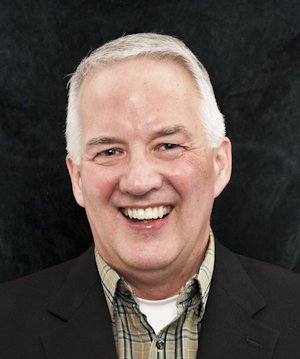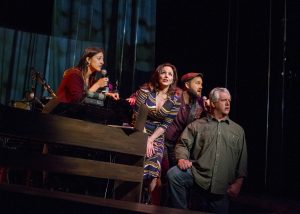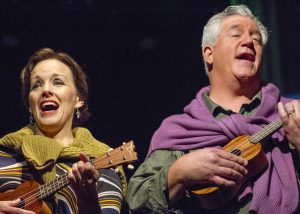The World Sort-of Needs a Nilsson Revue
The first question that demands to be asked about the San Diego REPertory Theatre world premiere of Everybody’s Talkin’: The Music of Harry Nilsson is, “Does the world need a Nilsson revue?” The second question is, “Is Alice Ripley’s voice ok?” The answer to both questions is “Yes, sort of.”
Harry Nilsson was kind of a mess as a person. He grew up in a broken home, got only through the ninth grade in school, and spent a lot of his life drunk or stoned. He wrecked his voice at a relatively early age, destroying what at its peak was a sweet tenor sound. Of his two biggest hits, one, “Everybody’s Talkin’,” was a cover of an obscure country song by Fred Neil, and the other, “One (Is the Loneliest Number),” was a hit for the band, Three Dog Night, while Nilsson’s own version became destined for the trash heap.
Despite his fame as Lennon and McCartney’s so-called favorite American pop artist (apparently, the Beatles’ publicist loved Nilsson’s early work and talked it up with his clients), there were other royalty in American pop music (Bob Dylan, Joni Mitchell, Paul Simon) who were not only bigger stars but who had far more sustained and distinguished careers. By comparison, Nilsson was a flash in the pan, though his work from the mid-60s through the early 70s contained several sparks of brilliance.
Nilsson’s musical writing spanned both pop and jazz. He also enjoyed writing for children and composing a few sly novelty numbers (such as his immediately recognizable “[You Put the Lime in the] Coconut”). He wrote the score for “The Point,” an animated feature about being different, which featured the song, “Me and My Arrow.” He championed the music of Randy Newman, when Newman was known only for being the nephew of famous Hollywood film composers.
Everybody’s Talkin’ is, however, about Nilsson’s music, not about Nilsson the man. In fact, Nilsson the man is fairly well ignored, except, perhaps, in the song, “You’re Breaking My Heart,” which is pretty close to the bone:
You’re breaking my heart
You’re tearing it apart
So fuck you
That’s the only one, though. The rest is a collection of material, a lot of it from Nilsson’s two hit albums, “Aerial Ballet,” (1968) and “Nilsson Schmilsson” (1971). To sing them, there’s two Tony® winners, Alice Ripley (Next to Normal) and Gregory Jbara (Billy Elliot the Musical). And, there’s Kürt, Kürt Norby, steadfast local actor who has often been cast in world premiere musicals presented by the Old Globe and the La Jolla Playhouse.
Actually, putting Kürt in the show was an excellent idea. Ms. Ripley’s voice is pretty low, as is Mr. Jbara’s. Nilsson was a tenor, and so is Kürt. To get some of the sound of the songs right, you need a tenor voice. You also need a soprano to fill out the sound, and musical director Korrie Paliotto fills that bill nicely. Band members Jessie Audelo and PJ Bovee also sing back-up vocals at times (the other band members are Isaac Crow and Dave Rumley).
I have to hand it to Steve Gunderson and Javier Velasco, who conceived the show. The vague notion that the songs take one through various stages of life, and especially the ebb and flow of relationships doesn’t matter much, nor does that conceit that it’s really the band’s show (by giving Ms. Paliotto the only lines in the show, at the beginning, intermission, and at the end). Mr. Gunderson’s arrangements are canny, often featuring one or both of Ms. Ripley and Mr. Jbara, but backing them up wisely. And, adding Mr. Norby means that there are songs in the show that might not have been there otherwise.
Of course, there is the issue of Ms. Ripley’s voice. The last time I and probably a lot of other San Diegans saw her, she was performing in the tour of Next to Normal. Despite having a voice that worked well with rock-and-roll Broadway shows (besides N2N, Ms. Ripley performed in The Who’s Tommy and The Rocky Horror Show), it was clear that several years of eight shows a week were taking its toll on her voice. I’m glad to report that here, Ms. Ripley’s voice is well-supported and clear. She favors her chest voice, and she had a tendency to push or (once or twice) belt in the upper register, but the arrangements (and the addition of Mr. Norby) favors her. Thanks for saving the voice, Ms. Ripley.
Mr. Jbara’s baritone favors the bass tones. It’s a rich voice, and he seems to enjoy telling a story with it. Mr. Velasco’s staging works best with him.
Mr. Norby’s tenor contrasts well (but, truth be told, doesn’t always blend as well) with the other two. He’s not as savvy a performer, but he does have plenty of power when needed.
Sean Fanning’s scenic design put the band in the center and allowed the performers to circle around the band, bringing them into and out of focus as needed. Greg Barnes’ costumes complimented the colors of the scenic design but didn’t always compliment the bodies of the performers. Kevin Anthenill’s sound design, once settled in, blended singers and band well. I didn’t “get” Daniel Fine’s projection design, however. The colors clashed with the rest of the production elements, and the patterns on the backdrop seemed pointless.
Everybody’s Talkin’: The Music of Harry Nilsson will be enjoyed by fans of Mr. Nilsson’s music and by fans of Ms. Ripley and Mr. Jbara. The rest of us may well find it to be a pleasant but not particularly memorable way to spend a couple of hours.
[box]This review was based on the opening night performance, May 30. The show runs through June 21 at the Lyceum Stage, in Horton Plaza. Park in the mall’s garage and bring your parking ticket to the theatre. The REP validates for four hours. The performance schedule varies from week to week, so check the REP’s website (linked below) for exact dates and times.
DOWNLOAD CAST AND CREDITS HERE[/box]
Video preview of the show
courtesy San Diego REPertory Theatre

In addition to reviewing theatre for San Diego Story, Bill also reviews for TalkinBroadway.com. He is a member of the San Diego Theatre Critics Circle and the American Theatre Critics Association. Bill is an emeritus professor in the School of Journalism and Media Studies at San Diego State University.





